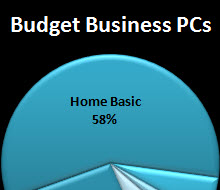Look who’s buying Vista Home Basic (hint: it’s not home users)

Who’s buying new PCs with Windows Vista Home Basic? Judging by the name, you’d assume those OS editions would be loaded on underpowered machines headed for tract homes in the burbs and studio apartments in the city. But you’d be wrong.
Based on my observations of the PC market over the past year or two, I think consumers have rejected Home Basic in favor of Home Premium. But small, budget-conscious businesses have embraced the low-end OS.

Take Dell’s Vostro 200, which is aimed squarely at the small-business market and starts at $269 with a Celeron 430 processor, 512MB of RAM, and no monitor. A much more capable machine with a Core 2 Duo processor, 2GB of RAM, and a 19-inch monitor sells for $449. All three machines in this line come with Windows Vista Home Basic. To upgrade to Vista Business or downgrade to XP Pro is another $99, which represents a huge percentage of the system cost.
The phenomenon is equally pronounced if you look at the Vostro notebook line, where more than half of all available configurations, 13 out of 24, include Vista Home Basic. By contrast, Dell’s consumer notebook line offers 34 separate configuration, of which only three start with Vista Home Basic. The remaining 90% come with Vista Home Premium (only one model includes Vista Ultimate by default).
You can see the same mix of Windows versions if you go to a business-focused reseller like CDW and look at a list of the cheapest available desktop computers, sorted by price in ascending order. Five of the 10 PCs on the list, including models from HP Compaq and Lenovo, come with Vista Home Basic. (Once you get past those low-end PCs, however, almost all computers sold at CDW include Vista Business.)
So how popular is Vista Home Basic, and who’s buying it?
Who's buying Vista Home Basic? See the details by segment -->
To get a snapshot of different segments of the PC market, I went to one of my favorite data sources: the Dell Outlet. At any given moment, there are thousands of systems on sale here, all of which were originally configured by customers and wound up on the resale shelf as a result of a return or canceled order. It’s easy to use Dell’s outlet search engine to filter the list of available products by configuration details, including operating system. (For more details on why I believe this data set represents a good proxy for the PC marketplace, go back and read the details from the last time I performed this exercise, in December 2007.)
As one of the two largest PC makers, Dell’s customers represent an excellent proxy for the market as a whole. As long as the sample size is large enough, the inventory here should mirror customer decisions out in Dell’s main store and those of its competitors. Even better, Dell divides its outlet inventory into easy-to-categorize segments. I chose three groups of data to analyze.
For the Budget Business PCs segment, I started at the Dell Business and Education Outlet and filtered the results to show only Vostro desktops and laptops, which are the entry-level line at Dell. For the High-End Business PCs segment, I looked at OptiPlex desktops and Latitude notebooks, both of which are aimed at corporate buyers and are built extremely well. For Consumer PCs, I looked at all available computers in all lines at the Dell Home and Home Office Outlet.
Here’s the data for Budget Business PCs:
As you can see, 58% of all PCs in this business segment are choosing systems configured with Vista Home Basic. That’s more than twice as many as the second-largest block, Vista Business. All other options, including Windows XP, are in single-digit percentages.
Now look at High-End Business PCs, where the mix is very different:
The overwhelming majority of PCs in this category, 94%, are running Windows Vista Business or XP Pro (usually installed using downgrade rights from a Vista Business license). I can think of two good reasons why buyers choose the higher-end Business (or XP Pro) version for machines in this class: they include the capability to join a Windows domain, and they can be upgraded using a volume license. Home Basic editions fail on both those criteria.
And finally, the Consumer PCs category:
Three out of four PCs in this category include Vista Home Premium. Only 14% are running Vista Home Basic. (And that percentage didn’t change when I filtered by price to look only at sub-$500 PCs.
On a percentage basis, at least in this sample, businesses are buying Vista Home Basic at four times the rate that consumers are.
An awful lot of cost-conscious businesses who don’t have to worry about corporate networks are choosing the lowest-priced edition of Windows. They don’t want bells and whistles or the complexity and higher price tag that comes with Business edition. That’s food for thought for anyone who thinks that Microsoft should offer only a home and a business edition.
It’s also food for thought for Microsoft. Maybe, for Windows 7, they could acknowledge this class of business buyer and give their entry-level OS a new, simpler name: Windows Basic.